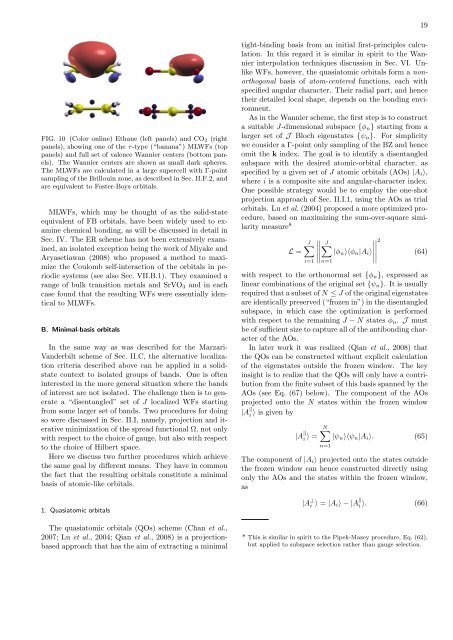Maximally localized Wannier functions: Theory and applications
Maximally localized Wannier functions: Theory and applications
Maximally localized Wannier functions: Theory and applications
You also want an ePaper? Increase the reach of your titles
YUMPU automatically turns print PDFs into web optimized ePapers that Google loves.
19<br />
FIG. 10 (Color online) Ethane (left panels) <strong>and</strong> CO 2 (right<br />
panels), showing one of the τ-type (“banana”) MLWFs (top<br />
panels) <strong>and</strong> full set of valence <strong>Wannier</strong> centers (bottom panels).<br />
The <strong>Wannier</strong> centers are shown as small dark spheres.<br />
The MLWFs are calculated in a large supercell with Γ-point<br />
sampling of the Brillouin zone, as described in Sec. II.F.2, <strong>and</strong><br />
are equivalent to Foster-Boys orbitals.<br />
MLWFs, which may be thought of as the solid-state<br />
equivalent of FB orbitals, have been widely used to examine<br />
chemical bonding, as will be discussed in detail in<br />
Sec. IV. The ER scheme has not been extensively examined,<br />
an isolated exception being the work of Miyake <strong>and</strong><br />
Aryasetiawan (2008) who proposed a method to maximize<br />
the Coulomb self-interaction of the orbitals in periodic<br />
systems (see also Sec. VII.B.1). They examined a<br />
range of bulk transition metals <strong>and</strong> SrVO 3 <strong>and</strong> in each<br />
case found that the resulting WFs were essentially identical<br />
to MLWFs.<br />
B. Minimal-basis orbitals<br />
In the same way as was described for the Marzari-<br />
V<strong>and</strong>erbilt scheme of Sec. II.C, the alternative localization<br />
criteria described above can be applied in a solidstate<br />
context to isolated groups of b<strong>and</strong>s. One is often<br />
interested in the more general situation where the b<strong>and</strong>s<br />
of interest are not isolated. The challenge then is to generate<br />
a “disentangled” set of J <strong>localized</strong> WFs starting<br />
from some larger set of b<strong>and</strong>s. Two procedures for doing<br />
so were discussed in Sec. II.I, namely, projection <strong>and</strong> iterative<br />
minimization of the spread functional Ω, not only<br />
with respect to the choice of gauge, but also with respect<br />
to the choice of Hilbert space.<br />
Here we discuss two further procedures which achieve<br />
the same goal by different means. They have in common<br />
the fact that the resulting orbitals constitute a minimal<br />
basis of atomic-like orbitals.<br />
1. Quasiatomic orbitals<br />
The quasiatomic orbitals (QOs) scheme (Chan et al.,<br />
2007; Lu et al., 2004; Qian et al., 2008) is a projectionbased<br />
approach that has the aim of extracting a minimal<br />
tight-binding basis from an initial first-principles calculation.<br />
In this regard it is similar in spirit to the <strong>Wannier</strong><br />
interpolation techniques discussion in Sec. VI. Unlike<br />
WFs, however, the quasiatomic orbitals form a nonorthogonal<br />
basis of atom-centered <strong>functions</strong>, each with<br />
specified angular character. Their radial part, <strong>and</strong> hence<br />
their detailed local shape, depends on the bonding environment.<br />
As in the <strong>Wannier</strong> scheme, the first step is to construct<br />
a suitable J-dimensional subspace {ϕ n } starting from a<br />
larger set of J Bloch eigenstates {ψ n }. For simplicity<br />
we consider a Γ-point only sampling of the BZ <strong>and</strong> hence<br />
omit the k index. The goal is to identify a disentangled<br />
subspace with the desired atomic-orbital character, as<br />
specified by a given set of J atomic orbitals (AOs) |A i ⟩,<br />
where i is a composite site <strong>and</strong> angular-character index.<br />
One possible strategy would be to employ the one-shot<br />
projection approach of Sec. II.I.1, using the AOs as trial<br />
orbitals. Lu et al. (2004) proposed a more optimized procedure,<br />
based on maximizing the sum-over-square similarity<br />
measure 8 2<br />
J∑<br />
J∑<br />
L =<br />
|ϕ<br />
∣∣<br />
n ⟩⟨ϕ n |A i ⟩<br />
(64)<br />
∣∣<br />
i=1<br />
n=1<br />
with respect to the orthonormal set {ϕ n }, expressed as<br />
linear combinations of the original set {ψ n }. It is usually<br />
required that a subset of N ≤ J of the original eigenstates<br />
are identically preserved (“frozen in”) in the disentangled<br />
subspace, in which case the optimization is performed<br />
with respect to the remaining J − N states ϕ n . J must<br />
be of sufficient size to capture all of the antibonding character<br />
of the AOs.<br />
In later work it was realized (Qian et al., 2008) that<br />
the QOs can be constructed without explicit calculation<br />
of the eigenstates outside the frozen window. The key<br />
insight is to realize that the QOs will only have a contribution<br />
from the finite subset of this basis spanned by the<br />
AOs (see Eq. (67) below). The component of the AOs<br />
projected onto the N states within the frozen window<br />
|A ∥ i ⟩ is given by N |A ∥ i ⟩ = ∑<br />
|ψ n ⟩⟨ψ n |A i ⟩. (65)<br />
n=1<br />
The component of |A i ⟩ projected onto the states outside<br />
the frozen window can hence constructed directly using<br />
only the AOs <strong>and</strong> the states within the frozen window,<br />
as<br />
|A ⊥ i ⟩ = |A i ⟩ − |A ∥ i ⟩. (66)<br />
8 This is similar in spirit to the Pipek-Mazey procedure, Eq. (62),<br />
but applied to subspace selection rather than gauge selection.













